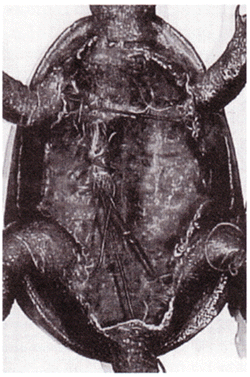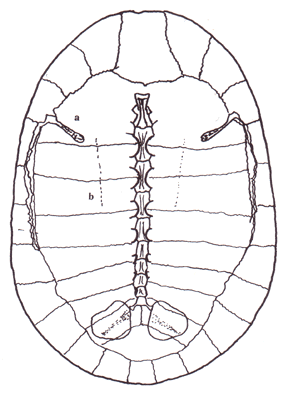The identification of the holotype of Chelodina oblonga (Testudines: Chelidae) with a discussion of taxonomic implications.
Character A: Anterior Bridge Strut - 0. Anterior bridge strut does not extend significantly onto pleural one. It curves posteriorly to run perpendicular to the rib gomphosis. 1. Anterior bridge strut extends postero-medially to contact the rib gomphosis at a point approximately half way to the thoracic vertebrae. No buttressing of the sutural surface present. 2.Anterior bridge strut extends postero-medially to cross the rib gomphosis at a point approximately half way to the thoracic vertebrae and continue some distance posteriorly to it. Heavy buttressing of the sutural surface present, increasing medially.
Results The C. expansa group can be diagnosed from the possession of enlarged retrahens capitus collique muscles which is evidenced in skeletal material by rugosities on the undersurface of the carapace. They are further diagnosed by the possession of a large anterior bridge strut that continues to further than half way to the thoracic vertebrae from its origins on the fourth peripheral. The longissimus dorsi muscles in this group are enlarged anteriorly only with expansion of the rib heads restricted to the first few vertebrae.

Figure 2. Ventral view of the holotype of Chelodina oblonga, with the plastron removed. To the left of the thoracic vertebrae is a disarticulated section of the cervical spine. To the right the rugosity of the retrahens capitus collique muscle can be seen as a feint white "scar" parallel to the thoracic vertebrae.
|
Discussion The three characters described here can diagnose the carapaces of the two groups within Chelodina. It is apparent that the holotype of C. oblonga is not the same as the current concept of C. oblonga from Perth. It would appear that the holotype is in actuality a specimen of what is currently referred to as C. rugosa from the Northern Territory, and that it may possibly have originated in Port Essington. Further morphological evidence of the distinction between the C. oblonga holotype and the current concept of C. oblonga from Perth can be gleaned from the description of C. colliei (Gray, 1856a), the next available name for the Perth species. In this paper Gray states that C. colliei (I hereby designate: BMNH 1947.3.5.91 as lectotype) could be differentiated from C. oblonga by the highly revolute marginals possessed by the former. The holotype of C. oblonga does not possess this character at all and this would indicate that Gray (1856a) intended that these be two separate species.

Figure 3. Ventral carapace surface of Chelodina siebenrocki (UC 0212). (a) anterior bridge strut; (b)attachment site rugosity of the retrehans capitus collique muscle. The ICZN (1999;Article 75.6) also allows for the conservation of prevailing usage by designation of a neotype. This rule applies to a situation as descibed here, where the holotype of a species name under prevailing usage is discovered to actually represent a specimen of a different species. One must then petition the ICZN to use its plenary power to set aside the original holotype and designate a neotype for the species. In this case, that would require that a neotype of C. oblonga be designated from a collection of animals from Perth, thereby allowing current prevailing usage of both names (C.oblonga and C.rugosa) to continue, and to avoid resurrection of the name C. colliei which has not been used for over 100 years.
|
